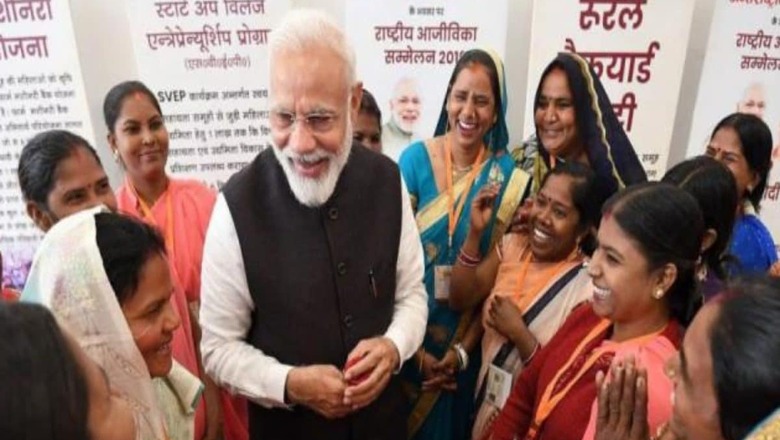
views
India was seen as a poor nation where uplifting crores of people was considered an incredibly difficult, if not an impossible task. Turns out, all that was needed was a determined leadership to intervene on this front and deliver rapid results. Since 2014, the share of India’s population living in multidimensional poverty is estimated to have fallen to 11.28 per cent. In 2014, that figure stood at 29.17 per cent. This means India lifted a staggering 24.82 crore people out of multidimensional poverty in just nine years.
What changed in 2014? The people of India, for the first time in 30 years, elected a majority government. Led by Narendra Modi, the BJP stormed to power. A decade since, it has become evident that the poor have emerged as the biggest beneficiaries of the electoral choice India made first in 2014, and then in 2019.
That is what the NITI Aayog’s discussion paper released on Monday has revealed. According to the think tank, which is principally tasked with devising new policies and improving upon existing ones, India will achieve single-digit poverty levels this year itself. For a country whose hallmark around the world not very long ago was poverty, this is indeed a landmark achievement. The paper also said India is likely to achieve Sustainable Development Goals (SDGs) or reduce multidimensional poverty by at least half, much ahead of 2030.
States like Uttar Pradesh, Bihar, Madhya Pradesh, Odisha and Rajasthan recorded the sharpest decline in the number of people classified as poor based on the Multidimensional Poverty Index (MPI).
Here’s some perspective: In 2005-06, the share of MPI poor in India’s total population was 55.34 per cent. Today, only about 11.82 per cent of the population can still be considered to be living in multidimensional poverty. Of course, the fact that the share of MPI poor people dropped from 55.35 per cent in 2005-06 to 29.17 per cent in 2014 cannot be ignored. This coincides with the tenure of the UPA 1 and 2 governments.
The NITI Aayog is not the only body extolling the strides India has taken towards poverty reduction. In fact, the World Bank had earlier noted that the share of India’s population living in extreme poverty had fallen from 18.7 per cent in 2015 to 12 per cent in 2021. In 2022, the United Nations said 415 million people exited multidimensional poverty in the country in 15 years between 2005-06 and 2019-21. According to UNDP estimates, the number of people who lived below the $2.15 per day poverty line had declined to 10 per cent in India in 2021. World Bank data also shows that the poverty headcount ratio in India, at $2.15 a day, decreased from 18.73 per cent in 2015 to 11.9 per cent in 2021.
That India has lifted crores of people out of multidimensional poverty can become a case study for the developing and underdeveloped world. For the Global South, India can serve as an example of how to deliver development to people who need it the most, while also reducing poverty through a slew of government interventions. India has started acting on this front already, as is evident from the growing interest of various countries in India’s massive digital public infrastructure (DPI), or even its physical infrastructure facilitator – the Gati Shakti Masterplan. The world is also stunned by the penetration that digital payments have achieved in India, which is why there is a global admiration for the United Payments Interface (UPI) today.
‘Garibi Hatao’ Not Just a Slogan Anymore
For the present government, “Garibi Hatao” is not just a political slogan meant to paint a sense of hope for the country’s poor and underprivileged. In recent times, Narendra Modi has sought to project the poor as his core constituency. Ensuring their development and uplifting them, therefore, has become the biggest policy objective of the Modi government. This objective is backed by a slew of initiatives and schemes, such as the Swachh Bharat Mission, Jal Jeevan Mission, Poshan Abhiyan, Samagra Shiksha, Pradhan Mantri Sahaj Bijli Har Ghar Yojana (Saubhagya), Pradhan Mantri Ujjwala Yojana, Pradhan Mantri Jan Dhan Yojana, Pradhan Mantri Awas Yojana – to name a few.
All such initiatives are meant to benefit the most underprivileged and marginalised people in India. The most intriguing part is that they all have very strong interlinkages. Whether it be building toilets and ensuring hygienic sanitation through the Swachh Bharat Mission, or providing tapped water connections to crores of households under the Jal Jeevan Mission – the end goal has been to provide the poor with all the basic amenities that they had been deprived of since independence.
Similarly, ensuring that everyone has a pucca house, and that such houses have electricity and LPG cylinder connections, while those who live in the said house have bank accounts and are connected to the digital world, is all being taken up on a mission mode at the Central governmental level. The goal is simple: lifting Indians out of poverty and giving them what they need to lead respectable lives.
At the same time, initiatives like Poshan Abhiyan and Anaemia Mukt Bharat have significantly enhanced access to healthcare facilities, leading to a substantial decrease in deprivation. Infant mortality has also fallen steadily, and as of 2020, India’s infant mortality rate was lower than South Africa’s.
The Modi government also runs the world’s biggest food security program, providing 81.35 crore beneficiaries free food grains across rural and urban India. Similarly, direct benefit transfers are now made straight into the bank accounts of beneficiaries. Therefore, corruption-related leakage has been minimised, and this has been made possible due to the creation of over 500 million new bank accounts since 2014 which are linked to Aadhaar.
Infrastructure is expected to become the biggest contributor to India’s economic growth in the coming years. The Centre plans to invest Rs 143 lakh crore on infrastructure between 2024 and 2030. That is double of what India has spent on infrastructure in the past seven years. Obviously, this has led to more jobs for Indians. Importantly, job demand in rural India under the MGNREGA initiative remains high, and is largely in sync with the increase in budgetary allocation for the scheme from Rs 32,992 crore in 2013-14 to Rs 60,000 crore in 2023-24. This has a lot to do with infrastructure now reaching rural India.
Similarly, as a result of the proactive efforts towards ‘Make in India’ and India’s aim to become a global manufacturing hub, Indian manufacturers posted a 36 per cent increase in job postings over the past year. Meanwhile, the Modi government has been transferring a sum of Rs 6,000 to farmers every year. If the whispers in the corridors of power are to be believed, this amount could be doubled in the interim budget presented by Finance Minister Nirmala Sitharaman next month.
This direct transfer has acted as a cushion for farmers, further enabling poverty reduction, especially among those who have small land holdings and crop yields. Meanwhile, with the e-National Agricultural Market (eNAM), farmers can now sell their produce to the highest bidder, thereby improving income levels.
Speaking about incomes, the weighted mean income in India rose from Rs 4.4 lakh in 2014 to Rs 13 lakh in FY23. In the same period, India’s per capita income in nominal terms almost doubled to Rs 1.72 lakh in 2022-23 as compared to Rs 86,647 in 2014-15. The State Bank of India has predicted that India’s per capita income is expected to increase from Rs 2 lakh ($2500) in FY23 to Rs 14.9 lakh ($12,400) in FY47.
More and more people are entering the middle class, which is a glowing testament to poverty reduction in India. Compared to 2011, 13.6 per cent of the population has left the lower-income strata and migrated upwards.
The bottom line is this: India is reducing multidimensional poverty fast. The ‘India Model’ can help other countries achieve the same. What is needed as a prerequisite though, is a committed leadership that is driven by the goal of eliminating poverty and raising people’s standards of living. Furthermore, the reduction and eventual elimination of poverty must not remain a mere governmental campaign. The participation of people from all walks of life is instrumental as well.
Views expressed in the above piece are personal and solely that of the author. They do not necessarily reflect News18’s views.



















Comments
0 comment